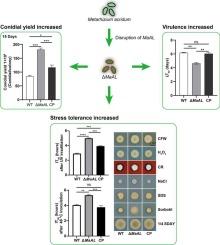一种类似Asp f2的蛋白对绿僵菌(Metarhizium acridum)的胁迫耐受性、分生和毒力有负面影响
IF 4
1区 农林科学
Q2 BIOCHEMISTRY & MOLECULAR BIOLOGY
引用次数: 0
摘要
绿僵菌是一种典型的丝状真菌,已被广泛用于防治蚱蜢、蝗虫和蟋蟀。基因工程是一种常用的策略,以提高其毒力,分生和抗逆性。在这里,我们报道了M. acridum Asp f2样蛋白(MaAL)在毒力、分生和胁迫耐受性中起关键作用。破坏MaAL (ΔMaAL)使分生孢子萌发速度加快,分生孢子产量显著提高。ΔMaAL菌株的分生孢子产量比野生型(WT)菌株高113.33%。ΔMaAL菌株对UV-B辐射、热休克和高渗透胁迫的耐受性显著增强。此外,局部接种和血液内注射均能显著提高对迁徙蝗的毒力。具体来说,与WT相比,局部接种ΔMaAL的LT50减少了1.54天,血腔内注射的LT50减少了1.08天。进一步的研究表明,MaAL的缺失导致附着胞的膨胀压力增加,蝗虫的免疫反应降低,血淋巴中菌丝生长加快。本研究探讨了Asp f2样蛋白在昆虫病原真菌中的功能,为开发高毒力菌株提供理论支持和遗传资源。本文章由计算机程序翻译,如有差异,请以英文原文为准。

An Asp f2-like protein negatively affects stress tolerance, conidiation and virulence in Metarhizium acridum
Metarhizium acridum is a typical filamentous fungus that has been widely used to control grasshoppers, locusts, and crickets. Genetic engineering is a common strategy to enhance its virulence, conidiation, and stress tolerance. Here, we report that the M. acridum Asp f2-like protein (MaAL) plays key roles in virulence, conidiation, and stress tolerance. Disruption of MaAL (ΔMaAL) resulted in faster conidial germination and significantly increased conidial yield. The conidial yield of the ΔMaAL strain was 113.33 % higher than that of the wild-type (WT) strain. The ΔMaAL strain exhibited significantly enhanced tolerance to UV-B irradiation, heat shock, and high osmotic stress. Furthermore, both topical inoculation and intra-hemocoel injection demonstrated significantly increased virulence against Locusta migratoria. Specifically, the LT50 of ΔMaAL was reduced by 1.54 days for topical inoculation and 1.08 days for intra-hemocoel injection compare to WT. Further investigation revealed that the deletion of MaAL led to increased turgor pressure in appressoria, reduced immune responses in locusts, and faster hyphal growth in the hemolymph. This study explores the function of Asp f2-like proteins in entomopathogenic fungi, providing theoretical support and genetic resources for the development of high-virulence strains.
求助全文
通过发布文献求助,成功后即可免费获取论文全文。
去求助
来源期刊
CiteScore
7.00
自引率
8.50%
发文量
238
审稿时长
4.2 months
期刊介绍:
Pesticide Biochemistry and Physiology publishes original scientific articles pertaining to the mode of action of plant protection agents such as insecticides, fungicides, herbicides, and similar compounds, including nonlethal pest control agents, biosynthesis of pheromones, hormones, and plant resistance agents. Manuscripts may include a biochemical, physiological, or molecular study for an understanding of comparative toxicology or selective toxicity of both target and nontarget organisms. Particular interest will be given to studies on the molecular biology of pest control, toxicology, and pesticide resistance.
Research Areas Emphasized Include the Biochemistry and Physiology of:
• Comparative toxicity
• Mode of action
• Pathophysiology
• Plant growth regulators
• Resistance
• Other effects of pesticides on both parasites and hosts.

 求助内容:
求助内容: 应助结果提醒方式:
应助结果提醒方式:


